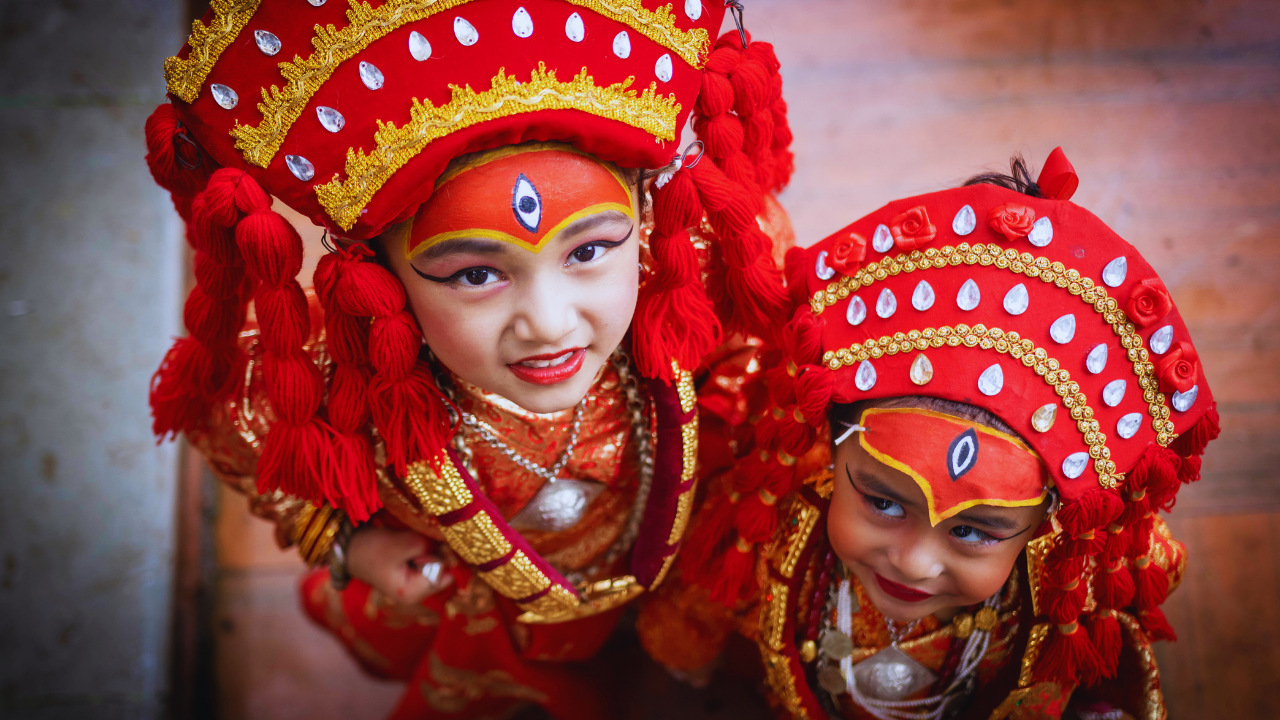Kumari, the living goddess of Nepal: History, traditions, and how to meet her in Kathmandu |

In the heart of Kathmandu’s old city, amid the chaos of ringing temple bells, swirling incense, and prayer flags fluttering in the breeze, lives a little girl who is no ordinary child. She is the Kumari, the only living goddess in the world. Chosen from a Buddhist community and worshipped by both Hindus and Buddhists, she is believed to be the earthly manifestation of Goddess Taleju (a form of Durga). In Nepal, where spirituality seeps into every corner of daily life, the idea of a living goddess isn’t a story from mythology, it’s a living, breathing tradition. Dressed in red silk and gold ornaments, with a painted third eye on her forehead, she is the Kumari, Nepal’s living goddess. Every day, hundreds of visitors stand silently in the courtyard of Kumari Ghar, a historic red-brick palace in Kathmandu. They wait for a fleeting moment when the child-goddess appears at the window, a brief glance that many believe can bring luck, health, and protection from misfortune. For a few seconds, the chaotic city stands still.
Who is the Kumari?

The word Kumari comes from the Sanskrit Kaumarya, meaning “princess” or “virgin.” She is considered the earthly embodiment of Goddess Taleju, a form of the powerful Hindu goddess Durga. What makes this tradition even more extraordinary is that the Kumari is chosen from a Buddhist family but worshipped by both Hindus and Buddhists.
A 2-year old becomes a goddess
In September 2025, Nepal welcomed a new Royal Kumari, two-year-old Aryatara Shakya, who replaced Trishna Shakya, the living goddess since 2017. On the eighth day of Dashain, Nepal’s biggest Hindu festival, Aryatara was carried to the Kumari Ghar by her family in a grand ceremony filled with music, rituals, and blessings. From that moment on, her divine journey began.
How the Kumari tradition began
The custom is said to have originated under King Jaya Prakash Malla in the seventeenth century. According to legend, the king and Goddess Taleju used to secretly play dice. However, the goddess disappeared in rage one evening after the queen unintentionally noticed them. She promised the king that she would return in the form of a young Newar girl before departing. Nepal has been worshipping the goddess in her living form ever since.
The selection process
Becoming the Kumari is no small feat. A group of senior Buddhist priests chooses the child after an intense and symbolic process: She must belong to the Shakya or Bajracharya family of the Newar community.She must be in perfect health, no scars, wounds, or lost teeth.She must possess the Battis Lakshanas, the 32 divine perfections believed to mark the body of a goddess.Her horoscope must align with that of the King. In an ancient ritual of courage, she must show no fear during symbolic trials involving blood and masked dancers, representing the fearlessness of Goddess Durga.Once chosen, she is ritually purified, believed to be possessed by Goddess Taleju, and officially declared the Living Goddess of Nepal.
Life inside the Kumari Ghar

The Kumari lives in near-seclusion inside the ornate Kumari Ghar of Kathmandu Durbar Square. She is either transported or carried in her golden palanquin if she ever leaves this compound. She spends her days taking part in ceremonial rites, studying with private tutors, and giving brief blessings to guests.When visitors come to seek blessings, even her smallest gestures, a smile, blink, or tear, are believed to predict their fortune. During major festivals like Indra Jatra, she is carried through the streets of Kathmandu in a golden chariot. Thousands gather to catch a glimpse of her — a moment believed to bring divine luck and protection.
What happens after her reign ends
A Kumari’s divinity ends when she experiences her first menstruation or sheds blood from an injury. She then returns to her family, attends school, and lives an ordinary life. Contrary to old myths, former Kumaris can marry, study, and work, many go on to lead successful, independent lives.Over the years, Nepal has also introduced reforms to ensure her education and well-being, balancing modern child rights with ancient cultural reverence.
How to meet the Living Goddess in Nepal
If you’re visiting Kathmandu, you can meet or see the Royal Kumari at her residence:Location: Kumari Ghar, Basantapur, Kathmandu Durbar SquareBest time to visit: Late morning to early afternoon (usually between 10 AM and 12 PM)Etiquette: Wait quietly in the courtyard. Remove your shoes and remain respectful. If the Kumari appears at the window, consider it a blessing — avoid shouting or clapping.You may also see her during public festivals like Indra Jatra (August–September), when she is carried in procession through the city.Even a brief sight of her is said to bring spiritual blessings and good fortune.
Why the tradition still matters
In a modern world where myths fade fast, the Kumari tradition stands as a living link between the divine and the human, between faith and identity. It’s a reminder that Nepal’s beauty isn’t just in its mountains and temples, it’s in the way it keeps ancient beliefs alive till this date.
var _mfq = window._mfq || [];
_mfq.push([“setVariable”, “toi_titan”, window.location.href]);
!(function(f, b, e, v, n, t, s) {
function loadFBEvents(isFBCampaignActive) {
if (!isFBCampaignActive) {
return;
}
(function(f, b, e, v, n, t, s) {
if (f.fbq) return;
n = f.fbq = function() {
n.callMethod ? n.callMethod(…arguments) : n.queue.push(arguments);
};
if (!f._fbq) f._fbq = n;
n.push = n;
n.loaded = !0;
n.version = ‘2.0’;
n.queue = [];
t = b.createElement(e);
t.async = !0;
t.defer = !0;
t.src = v;
s = b.getElementsByTagName(e)[0];
s.parentNode.insertBefore(t, s);
})(f, b, e, ‘https://connect.facebook.net/en_US/fbevents.js’, n, t, s);
fbq(‘init’, ‘593671331875494’);
fbq(‘track’, ‘PageView’);
};
function loadGtagEvents(isGoogleCampaignActive) {
if (!isGoogleCampaignActive) {
return;
}
var id = document.getElementById(‘toi-plus-google-campaign’);
if (id) {
return;
}
(function(f, b, e, v, n, t, s) {
t = b.createElement(e);
t.async = !0;
t.defer = !0;
t.src = v;
t.id = ‘toi-plus-google-campaign’;
s = b.getElementsByTagName(e)[0];
s.parentNode.insertBefore(t, s);
})(f, b, e, ‘https://www.googletagmanager.com/gtag/js?id=AW-877820074’, n, t, s);
};
function loadSurvicateJs(allowedSurvicateSections = []){
const section = window.location.pathname.split(‘/’)[1]
const isHomePageAllowed = window.location.pathname === ‘/’ && allowedSurvicateSections.includes(‘homepage’)
const ifAllowedOnAllPages = allowedSurvicateSections && allowedSurvicateSections.includes(‘all’);
if(allowedSurvicateSections.includes(section) || isHomePageAllowed || ifAllowedOnAllPages){
(function(w) {
function setAttributes() {
var prime_user_status = window.isPrime ? ‘paid’ : ‘free’ ;
var geoLocation = window?.geoinfo?.CountryCode ? window?.geoinfo?.CountryCode : ‘IN’ ;
w._sva.setVisitorTraits({
toi_user_subscription_status : prime_user_status,
toi_user_geolocation : geoLocation
});
}
if (w._sva && w._sva.setVisitorTraits) {
setAttributes();
} else {
w.addEventListener(“SurvicateReady”, setAttributes);
}
var s = document.createElement(‘script’);
s.src=”https://survey.survicate.com/workspaces/0be6ae9845d14a7c8ff08a7a00bd9b21/web_surveys.js”;
s.async = true;
var e = document.getElementsByTagName(‘script’)[0];
e.parentNode.insertBefore(s, e);
})(window);
}
}
window.TimesApps = window.TimesApps || {};
var TimesApps = window.TimesApps;
TimesApps.toiPlusEvents = function(config) {
var isConfigAvailable = “toiplus_site_settings” in f && “isFBCampaignActive” in f.toiplus_site_settings && “isGoogleCampaignActive” in f.toiplus_site_settings;
var isPrimeUser = window.isPrime;
var isPrimeUserLayout = window.isPrimeUserLayout;
if (isConfigAvailable && !isPrimeUser) {
loadGtagEvents(f.toiplus_site_settings.isGoogleCampaignActive);
loadFBEvents(f.toiplus_site_settings.isFBCampaignActive);
loadSurvicateJs(f.toiplus_site_settings.allowedSurvicateSections);
} else {
var JarvisUrl=”https://jarvis.indiatimes.com/v1/feeds/toi_plus/site_settings/643526e21443833f0c454615?db_env=published”;
window.getFromClient(JarvisUrl, function(config){
if (config) {
const allowedSectionSuricate = (isPrimeUserLayout) ? config?.allowedSurvicatePrimeSections : config?.allowedSurvicateSections
loadGtagEvents(config?.isGoogleCampaignActive);
loadFBEvents(config?.isFBCampaignActive);
loadSurvicateJs(allowedSectionSuricate);
}
})
}
};
})(
window,
document,
‘script’,
);
Source link




